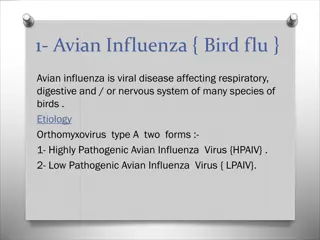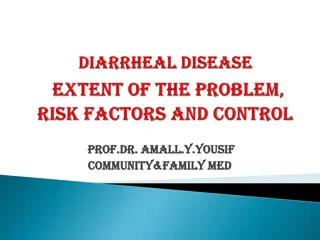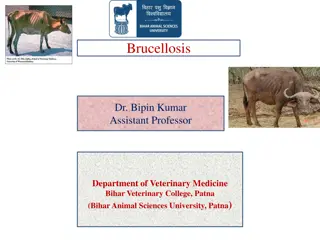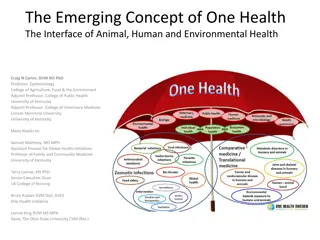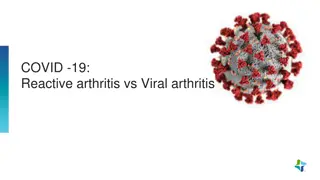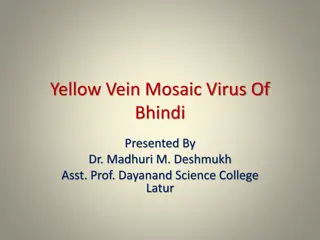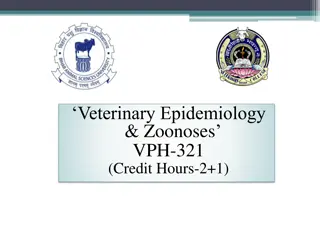Understanding Zoonotic Hepatitis A Virus Infections
Zoonotic hepatitis A virus infections primarily affect humans and nonhuman primates, with transmission occurring through fecal-oral route. This article delves into the reservoir, mode of transmission, clinical signs, and diagnosis of hepatitis A, shedding light on its impact on both species. Nonhuman primates play a crucial role in research on viral hepatitis, particularly in the study of hepatitis A, B, C, D, and E infections. The clinical presentation varies from mild illness to severe manifestations, with humans experiencing a more severe disease course compared to nonhuman primates. Proper diagnosis of hepatitis A is essential, as the disease cannot be differentiated based on clinical or epidemiological features alone.
Download Presentation

Please find below an Image/Link to download the presentation.
The content on the website is provided AS IS for your information and personal use only. It may not be sold, licensed, or shared on other websites without obtaining consent from the author. Download presentation by click this link. If you encounter any issues during the download, it is possible that the publisher has removed the file from their server.
E N D
Presentation Transcript
Zoonotic disease Lecturer muna tawfeeq
Viral Hepatitis Infections hepatitis is one of systemic infections in humans caused by the nonhuman primate zoonoses . However, of the viral infections that target the liver as the primary site of involvement, only hepatitis A virus (HAV) has proven to be a significant zoonotic pathogen in the laboratory animal facility environment. Nonhuman primates are important experimental hosts in viral hepatitis research and have been used to study hepatitis A, B, C, D, and E infections Other viruses known to induce hepatitis in naturally acquired infections of laboratory animal species include the coronavirus, mouse hepatitis virus; the adenovirus, infectious canine hepatitis virus; and the hepadnavirus, woodchuck hepatitis virus. None of these are recognized zoonotic agents.
Hepatitis A Reservoir and Incidence HAV is a human enterovirusbelonging to the family Picornaviridae. The primary reservoirs for HAV infection are humans, with nonhuman primate infections resulting from contact with infected humans or other infected nonhuman primates. Seasonal distribution HA: most cases developed in autumn and winter HE: most cases developed in summer and autumn
Mode of Transmission Normal habitat of this virus is intestinal tract Transmission generally occurs as a result of ingestion of virus shed in the faecesof infected persons(fecal-oral route). Close personal contact is the most common mode of HAV transmission families, day care centres Contaminated food and water can also serve as vehicles of HAV transmission HAV can survive for 12 weeks to 10 months in water, so infection can occur by ingestion of a variety of raw shellfish harvested from sewage- contaminated areas. Waterborne outbreaks have also been reported in association with drinking faecallycontaminated water.
Clinical Signs The disease in nonhuman primates is much less severe than in humans and is frequently subclinical. characterized by malaise, vomiting, jaundice, and elevated serum levels of hepatic enzymes. The disease in humans varies from a mild illness lasting less than 2 months to a severely debilitating illness lasting up to 6 months. Following an incubation period of approximately 1 month, patients experience an abrupt onset of fever, malaise, anorexia, nausea, joint pain, and abdominal discomfort followed within a few days by jaundice . Children often have mild disease without jaundice, whereas HAV infections in older patients may be fulminant and protracted with prolonged convalescence. However, protracted HAV infection is considered an acute infection that is ultimately resolved by the patient; a chronic hepatitis A carrier state has never been shown to exist. Infection confers lifelong immunity
Diagnosis Diagnosis of hepatitis A Cannot be differentiated on clinical or epidemiological features. Serologic testing to detect IgM-specific anti-HAV antibody to the capsid proteins. Commercial diagnostic ELISA kits available by demonstration of elevated total combined IgM and IgG anti- HAV antibodies in the serum or plasma. detection of HAV RNA in the blood or feces is considered diagnostic of active infections. The presence of IgG anti-HAV antibodies is useful in detecting previous infection.
Prevention Prevention The use of protective clothing, personal hygiene, and appropriate sanitation practices for equipment and facilities will also minimize the potential for zoonotic transmission . Vaccines Cell-culture-adapted virus fibroblasts Purified from cell lysates Formalin inactivated, and Adsorbed to an aluminium hydroxide adjuvant propagated in human
Hepatitis E Virus Hepatitis E virus (HEV) is unique among the major hepatitis viruses (A, B, C, and D) in that animals serve as natural reservoirs of the virus HEV is classified in the genus Hepevirus and is currently subdivided into at least four major genotypes, Genotypes 1 and 2 infect only humans; genotypes 3 and 4 can infect both humans and a range of other species involved in zoonotic transmission of the virus. HEV infects people worldwide, causing a sometimes fatal viral hepatitis . Its detection in animal populations has steadily risen in the recent past, thereby prompting increased concern of its zoonotic potential
Mode of Transmission In human populations, hepatitis E was originally believed to result most commonly from human fecal contamination of drinking water in areas endemic for the disease. Recent research has focused on the role that many animal species may play in zoonotic disease transmission from the feces of infected animals and the consumption of undercooked, contaminated animal tissues (meat and liver) . Aerosol transmission is not suspected. Unlike hepatitis A virus, which is also transmitted by the faecal-oral route, person-to-person transmission of HEV appears to be uncommon.
Clinical Signs Disease is frequently self-limiting and asymptomatic, although an acute hepatitis can develop with classical signs of liver involvement including jaundice, anorexia, and hepatomegaly. A fulminant , fatal hepatitis of pregnant women has been attributed to HEV infection, Chronic disease may develop in the immunocompromised including transplant recipients
Diagnosis and Prevention Detection of anti-HEV antibodies or the presence of HEV RNA in serum or feces . Treatment is limited to provision of supportive care. A hepatitis E vaccine is not currently available.
Hepatitis B virus Worldwide 350 million people persistently infected and a quarter of them will die as a consequence of hepatic disease Hepadnavirus ,DNA enveloped virus
Hepatitis B clinical features Incubation period 60-90 days Clinical illness in 30-50% of people Acute case fatality rate 0.5-1% Chronic infection in 2-10% of people Premature mortality associated with chronic liver disease occurs in 15-25% of chronically infected people Chronic liver disease either cirrhosis or liver cancer
diagnosis Detection of HBsAg in serum by ELISA indicates active infection Detection of antibody to HBsAg by ELISA presence of IgM indicates recent infection prevention Recombinant HBsAg 3 doses Protective antibodies develop in 96-97% of persons
hepatitis C virus (HCV) HCV is a member of flavivirus family
most persons infected with HCV develop chronic infection. Why?
Hepatitis D virus HDV is a defective single-stranded RNA virus that requires the helper function of HBV to replicate. HDV infection can be acquired either as a co-infection with HBV or as a superinfection of persons with chronic HBV infection. Persons with HBV-HDV co-infection may have more severe acute disease and a higher risk of fulminant hepatitis compare d with those infected with HBV alone. In general, the global pattern of HDV infection corresponds to the prevalence of chronic HBV infection
Persons at increased risk of infection of hepatitis viruses Travelers Injecting drug users Tattooing person Sewerage worker Sharing special equipment Eating contaminated food by infected Food handler. Unsafe sex Note:hepatitis b,c and d (Insect transmission)
Laboratory examination Liver function test Serum transaminase ALT(alanine transferase) AST(aspartase transferase) ALP (Alkaline phosphatase) in chronic hepatitis LDH (Lactate dehydrogenase) Serum protein Albumin In chronic hepatitis Ig The ratio of A/G (albumin to globulin ratio) Bilirubin Ultra-sound examination Liver biopsy Other laboratory examination Blood routine Urine routine























